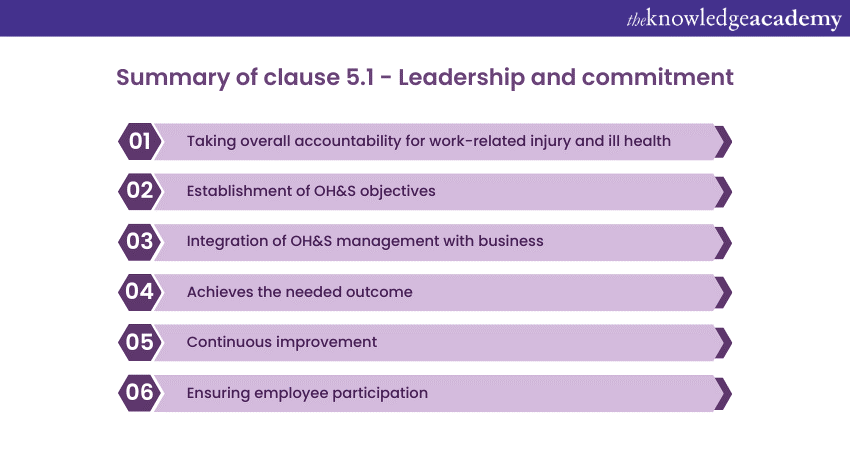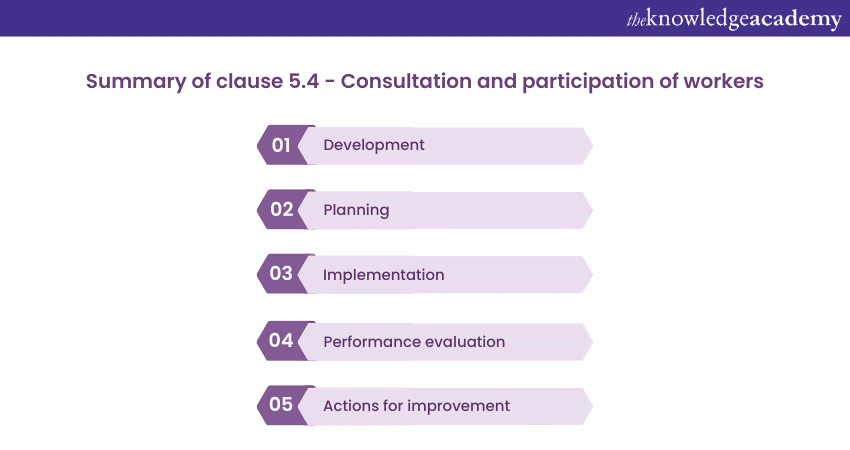We may not have the course you’re looking for. If you enquire or give us a call on 01344203999 and speak to our training experts, we may still be able to help with your training requirements.
Training Outcomes Within Your Budget!
We ensure quality, budget-alignment, and timely delivery by our expert instructors.

ISO 45001 Leadership plays a pivotal role in establishing and maintaining an effective ISO 45001 health and safety management system within organisations. With the increasing focus on workplace safety and the well-being of employees, management's commitment to Occupational Health and Safety (OH&S) has become crucial for organisations to thrive in today's competitive landscape.
Leadership sets an example for the entire organisation by championing safety, emphasising the importance of compliance with OH&S standards, and leading by example. This blog will explore the role of ISO 45001 Leadership in successfully implementing ISO 45001, the international occupational health and safety standard.
Table of Contents
1) Importance of ISO 45001 Leadership in its implementation
2) Leadership commitment to occupational health and safety
3) Integrating OH&S policies into management
4) Leading by example
5) Empowering employees and encouraging participation
6) Conclusion
Importance of ISO 45001 leadership in its implementation
Leadership plays a pivotal role in shaping an organisation's OH&S culture and driving the successful implementation of ISO 45001. Without solid management, efforts to comply with the standard may fall short, leading to potential risks and safety hazards.
First and foremost, leaders set the strategic direction for the organisation. By embracing ISO 45001 and its principles, leaders are committed to creating a safe and healthy work environment. This commitment conveys to employees that their well-being is a top priority.
When leaders actively participate in the implementation, it signals to employees that complying with the standard is not a mere checkbox exercise but a genuine commitment to continuous improvement. Furthermore, leaders have the authority to allocate necessary financial and human resources to ensure the successful implementation of ISO 45001.
Leaders also play an essential role in driving employee engagement and motivation. By actively communicating the importance of OH&S and involving employees in decision-making processes, leaders foster a sense of ownership and responsibility among the workforce.

Leadership commitment to occupational health and safety
The ISO 45001 Leadership is essential for effectively implementing the standard and making the workplace healthy and safe. It involves actively prioritising and encouraging occupational health and safety within the organisation. Clause 5.1 of ISO 45001 outlines the specific requirements for leadership and commitment to the occupational health and safety management system.

Here are the key actions and responsibilities that management must undertake to demonstrate leadership and commitment:
Setting clear objectives
Leaders must establish clear and measurable OH&S objectives aligned with the organisation's goals. These ISO 45001 Objectives should be communicated throughout the organisation to ensure everyone understands the importance of safety and the specific targets to strive for.
Establish OH&S policy
Management must develop, document, and communicate an OH&S policy relevant to the organisation's context and purpose. This policy should provide a framework for setting OH&S objectives and demonstrate the commitment to continual improvement.
Assign roles and responsibilities
Management must assign responsibilities and authorities for key OH&S functions within the organisation. This includes designating personnel who are accountable for implementing and maintaining the OH&S management system, ensuring compliance with legal requirements, and promoting employee participation.
Integrate OH&S into business processes
Management should ensure the OH&S management system is integrated into the organisation's overall business processes. This involves aligning OH&S objectives with the strategic goals, considering OH&S risks and opportunities during decision-making processes, and integrating OH&S into planning and operational activities.
Provide adequate resources
Management must allocate appropriate resources to implement, maintain, and improve the OH&S management system. This includes providing sufficient financial, human, and technological resources to support OH&S initiatives, training programs, hazard identification, risk assessment, and control measures.
Communication and consultation
Management should establish effective communication channels to engage and consult with employees and other relevant interested parties regarding OH&S matters. This includes promoting two-way communication, actively seeking input and feedback, and ensuring that OH&S information is accessible to all employees.
Learn all the fundamental knowledge about ISO 45001 and know how to implement occupational health and safety in your organisation with our ISO 45001 Foundation training.
Set objectives and performance indicators
Management must establish measurable OH&S objectives and define performance indicators to assess the effectiveness of the OH&S management system. These objectives should be aligned with legal requirements, industry best practices, and the organisation's OH&S policy.
Demonstrate leadership and employee involvement
Management should actively demonstrate leadership and commitment to OH&S by participating in such activities, leading by example, and promoting employee involvement. This includes participating in hazard identification and risk assessment processes, supporting employee participation in health and safety committees or forums, and recognising and rewarding contributions to improving OH&S performance.
Continual improvement
Management must ensure the continual improvement of the OH&S management system by monitoring performance, conducting regular audits, and taking corrective actions to address identified non-conformities or areas for improvement.
By fulfilling these ISO 45001 Requirements outlined in Clause 5.1 of ISO 45001, management can effectively demonstrate their leadership and commitment to making the workplace healthy and safe, fostering a safety culture, and continuously improving the organisation's occupational health and safety performance.
Learn how to implement an occupational health and safety management system that meets international standards with ISO 45001 Lead Implementer training.
Integrating OH&S policies into management
Management plays a vital role in establishing, maintaining and implementing the OH&S policies. These policies must be well documented and communicated within the organisation. It must also be available to all the workers and stakeholders. Clause 5.2 of ISO 45001 guides how management can effectively establish, maintain, and implement OH&S policies. Here's an explanation of the key actions management must take:
a) Develop clear OH&S policies aligned with objectives and legal requirements, addressing hazards, risks, compliance, and continual improvement.
b) Effectively communicate policies to employees through various channels and ensure easy accessibility.
c) Provide training and awareness programs to ensure employees comprehend their roles and responsibilities and the organisation's expectations.
d) Align operational activities with policies, conduct audits, and implement corrective actions.
e) Periodically review policies, consider changes, and update as required.
f) Encourage employee involvement in policy development, review, and improvement.
g) Regularly monitor compliance, conduct audits, and take actions to address non-compliance.
h) By following these guidelines in Clause 5.2, management can effectively integrate OH&S policies into the organisation's management system, ensuring a safe and healthy work environment.
Become an internal auditor and ensure your organisation's compliance with international standards with ISO 45001 Internal Auditor training.
Establishing clear roles and responsibilities
Establishing clear roles and responsibilities within the ISO 45001 framework is crucial for effectively implementing and maintaining the OH&S management system. By establishing clear roles and responsibilities, management ensures that the organisation operates smoothly, promotes OH&S compliance, and effectively addresses risks and hazards. It fosters a culture of shared responsibility and empowers individuals to contribute to a safe working environment. Here's why it matters and what management needs to do.
Assigning OH&S responsibilities
Management must assign specific OH&S responsibilities to individuals or teams at all levels of the organisation. This ensures everyone understands their role in maintaining a safe work environment and actively contributes to OH&S objectives.
Defining roles and authorities
Clearly defined roles and authorities are essential to avoid confusion and ensure accountability. Management should clearly outline the responsibilities, decision-making authority, and reporting lines for each role involved in OH&S management.
Communicating roles and responsibilities
Management must effectively communicate assigned roles and responsibilities throughout the organisation. This includes providing clear job descriptions, updating organisational charts, and facilitating open communication channels to clarify queries or concerns.
Training and competence development
The management should ensure that individuals assigned OH&S responsibilities have the necessary training and competence to fulfil their roles effectively. This may involve providing relevant training programs, certifications, and continuous learning opportunities to enhance knowledge and skills.
Cross-functional collaboration
Management should foster collaboration among different departments and teams to address OH&S issues collectively. This includes promoting information sharing, joint problem-solving, and encouraging multidisciplinary cooperation to improve OH&S performance.
Performance evaluation and recognition
Management should establish mechanisms to evaluate and recognise individuals or teams for OH&S performance. Regular performance reviews, feedback, and recognition programs motivate the employees to fulfil their responsibilities actively.
Leading by example
Leading by example is crucial for the successful ISO 45001 implementation and for cultivating a robust health and safety culture. Management plays a pivotal role in demonstrating the importance of safety through their actions.
By consistently practising what they preach, management clearly expects employees to prioritise safety in their daily activities. When leaders comply with OH&S policies and procedures, it reinforces the importance of adherence for everyone else. Participating in hazard identification, risk assessment, and control measures demonstrates a commitment to creating a safer work environment. The leadership and management can perform the following tasks to lead by example and promote health and safety in the workplace:
a) Embodying safety practices
b) Compliance with policies and procedures
c) Prioritising hazard identification and risk management
d) Communication and engagement
e) Encouraging reporting and feedback
f) Continuous learning and improvement
h) Reorganising and rewarding safety practices
Join our ISO 45001 Lead Auditor training to help organisations improve their health and safety in the workplace.
Empowering employees and encouraging participation
Empowering employees and promoting their active participation in OH&S initiatives is key to successful ISO 45001 implementation. Clause 5.4 of ISO 45001 emphasises the importance of worker participation at all applicable levels and functions and the involvement of workers' representatives in various aspects of the OH&S management system.

Here's how management can encourage participation from employees in developing, planning, implementing, evaluating performances, and determining the improvement actions:
a) Development: Management should involve workers and their representatives, such as unions, in developing OH&S policies, procedures, and programs. This ensures that their insights and expertise are considered, leading to more comprehensive and effective measures.
b) Planning: Workers' participation is crucial during the planning phase, where they can provide valuable input on hazard identification, risk assessment, and establishing control measures. Their involvement helps to ensure that the plans are practical, realistic, and aligned with the realities of the workplace.
c) Implementation: Workers should be actively involved in implementing OH&S practices, including the execution of control measures, use of Personal Protective Equipment (PPE), and adherence to safe work procedures. This participation fosters a sense of ownership and responsibility for their safety and that of their colleagues.
d) Performance evaluation: Management should engage workers in evaluating OH&S performance through feedback, reporting incidents and near misses, and participating in inspections and audits. Their input provides valuable insights into potential areas for improvement.
e) Actions for improvement: Workers and their representatives should be involved in identifying and implementing actions for continuous improvement. This includes participating in root cause analysis, suggesting corrective measures, and actively engaging in decision-making.
By actively involving workers and their representatives, management ensures that the OH&S management system reflects the needs and experiences of those on the front lines. This collaborative approach fosters a culture of shared responsibility, ownership, and continuous improvement, ultimately leading to a safer and healthier workplace.
Conclusion
ISO 45001 Leadership is vital in establishing and maintaining an effective OH&S management system. Strong leadership commitment, integration of policies, clear roles and responsibilities, leading by example, and empowering employee participation are key factors for success. Organisations can foster a culture of prevention, compliance, and continuous improvement by prioritising occupational health and safety. With ISO 45001 Leadership at the forefront, organisations can create safer workplaces, protect employee well-being, and achieve long-term success.
Learn about ISO 45001 and improve your organisation’s health and safety with our comprehensive ISO 45001 Training courses.
Frequently Asked Questions
Upcoming Health & Safety Resources Batches & Dates
Date
 ISO 45001 Foundation
ISO 45001 Foundation
Mon 22nd Jul 2024
Mon 23rd Sep 2024
Mon 11th Nov 2024
Mon 10th Feb 2025
Mon 19th May 2025
Mon 8th Sep 2025
Mon 8th Dec 2025







 Top Rated Course
Top Rated Course


 If you wish to make any changes to your course, please
If you wish to make any changes to your course, please


